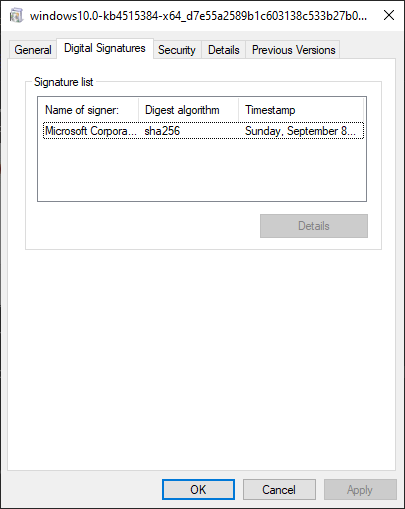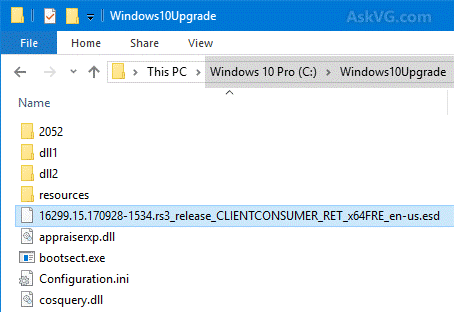I will assume that you have already unsuccessfully tried windows update troubleshoot in your OS setting (If not simply type Settings in your seach box, open the App, select Update and Security, in the left menu click on 'Troubleshoot', then choose Windows Update and follow the instructions).
How to Fix Error Code 0x8007000d and Windows 10 Update 1809 to 1903 Step by Step
- Open the command prompt (either type cmd in your search box, right click command prompt and run as administrator, or press simulteously WIN + X)
- Run each and every commands below one after the other (copy and paste + enter). Please note that this may take some time. Be Patient
- WSReset.exe
- dism /online /cleanup-image /restorehealth
- dism /online /cleanup-image /StartComponentCleanup
- sfc /scannow
- powershell
- Get-AppXPackage -AllUsers |Where-Object {$_.InstallLocation -like “*SystemApps*”} | Foreach {Add-AppxPackage -DisableDevelopmentMode -Register “$($_.InstallLocation)AppXManifest.xml”}
Execute the above commands in the command prompt and restart your system to let the changes takes place. Check now if this error code 0x8007000d is fixed or not. Try to restart your windows update. You may want to use WIndows 10 update assistant.
Original product version: Windows 10, version 1809 and later versions, Windows Server 2012 R2, Windows 7 Service Pack 1, Windows Server 2008 R2 Service Pack 1 Original KB number: 947821. Windows updates and service packs may fail to install if there are corruption errors. For example, an update might not install if a system file is. Method 2: Manually reset the Windows Update components. Resetting the Windows Update components can solve a few issues with it, and this is one of those issues, so this is definitely worth trying. Press Windows and X, and choose Command Prompt (Admin) from the menu that appears in the lower left corner.
Windows 10 Update Assistant Error 0x80070002
- In this videio i have showed how you can easily fix the error code 0x8007000d by follwing few step by your self with the help of the command prompt menu just.
- This vid helps Fix error code 0x8007000D - 0x90002 while trying to update your system to the latest Windows 10. To effectively remove your antivirus software.
- Have multiple computers with 3 different customers Windows 10 Pro in WorkgroupWindows failed to install the following update with e. 3 replies Windows 10.
If the above fail you may try the DISM tool process as follows:
Open the command prompt (run as admin) and follow each of the following command.
- dism /online /cleanup-image /restorehealth
- dism /online /cleanup-image /StartComponentCleanup
Ensure that you press enter after each command. Once executed restart your system to make the changes takes place and then check if the error code is fixed or not.
If all the above fail you may need to Reset or restore your PC. Search online for instructions.
If you like this article please add a link to it from your site, blog, facebook page, twitter or any online page. Thank you.
The Error 0x8007000d is quite an unusual error, in the sense that it appears in different scenarios. You may encounter the error when installing, upgrading, updating or activating Windows 10. In this post, we will attempt to provide the most suitable solutions that you can try to successfully resolve the issue in relation to the respective error scenarios.
How To Fix Error 0x8007000d
Error 0x8007000d when installing Windows 10
This error indicates the bootable installation media you are using is corrupt – that’s why the Windows 10 installation failed. In this case, you will need to re-create that installation media and try the install process again – it should complete successfully without any errors.
Error 0x8007000d when upgrading or updating Windows 10
The Windows Update error 0x8007000d occurs mainly due to two reasons – corrupt system files or the Windows update components have become obsolete. This won’t let you install any updates for Windows and it also won’t let you upgrade Windows 10 in case a newer version is available.
When you encounter this error, you won’t be able to apply the monthly security patches on the existing operating system. You may sometimes succeed to initiate the upgrade via Windows Update. However, this will either fail or get stuck at a certain percentage.

So, if you’re faced with this issue, you can try our recommended solutions below in no particular order and see if that helps to resolve the issue.
Let’s take a look at the description of the process involved concerning each of the listed solutions.
1] Run Windows Update Troubleshooter
More often than not, running the inbuilt Windows Update Troubleshooter fixes update errors on Windows 10. After you run the troubleshooter and rerun Windows update but still receive the error, you can try the next solution.
2] Run SFC scan
3] Run DISM scan

4] Reset Windows Update components to the default
In this solution, you can use the Reset Windows Update Agent Tool and see if it helps you. This PowerShell script will help you Reset Windows Update Client. Also, you may want to manually reset each Windows Update components to default.
If you’re having this issue installing the cumulative update via Windows Update, you can manually download from the Microsoft Update Catalog, the update that is failing to install and consequently triggering the update error, and then install the update on your Windows 10 PC.
Alternatively, you may use the Windows 10 Update Assistant to install the Feature Update.

More tips to fix: Windows Update, System Restore or Activation error code 0x8007000D.
Error 0x8007000d when activating Windows 10
You may encounter this activation error when you try run the slmgr -dlv or slmgr -ato command. This error can be caused because of insufficient permission to the ‘root’ directory. The System account by default has Full Control permissions to the registry path:
and any subkeys. If those permissions have been altered for the ‘Root’ key or any subkey(s), you would see the error code 0x8007000D.
So, if you’re faced with this issue, you can try our recommended solutions below in no particular order and see if that helps to resolve the issue.
Let’s take a look at the description of the process involved concerning each of the listed solutions.
Before you try any of the solutions below, you can quickly run an SFC scan, followed by a DISM scan (if necessary) then retry the activation. If that doesn’t resolve your issue, you can then proceed.
1] Run Windows 10 Activation Troubleshooter
The Windows Activation Troubleshooter will help you address the most commonly encountered activation issues on Genuine Windows devices including those caused by hardware changes. This solution requires you to run the inbuilt Windows 10 Activation Troubleshooter and see if that would be of any help. Else, you can try the next solution.
2] Perform a Clean Boot and retry activation
There have been instances where some programs interfered with the activation process. This solution requires you to perform a Clean Boot – this will disable any active security programs or third party programs running in the background. Once your Windows 10 device is running in the clean boot state, you can try to activate Windows 10 again.
3] Assign the minimum permission of “Enumerate Subkeys” to the System account
Since this is a registry operation, it is recommended that you back up the registry or create a system restore point as necessary precautionary measures. Once done, you can proceed as follows:
- At the location, on the left pane, right-click on the ROOT folder and select Permission.
You can now retry activating. If you’re still unable to activate, try the next solution.

4] Activate by Phone
Microsoft phone activation is one of the ways to activate Microsoft Windows or Microsoft Office products. Generally, it requires calling the Microsoft Activation Center and to verbally exchange activation information.
Hope you find this post useful!